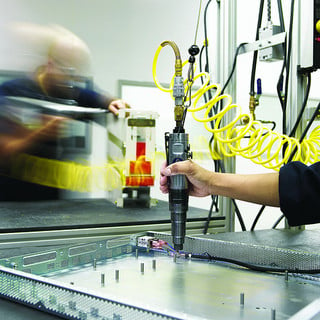 One of the most basic choices any electronics assembler has to make is whether to build the circuit board using Through-Hole Mounting (THM) or Surface Mount Technologies (SMT).
One of the most basic choices any electronics assembler has to make is whether to build the circuit board using Through-Hole Mounting (THM) or Surface Mount Technologies (SMT).
THM is the older of the two processes, and is exactly what it sounds like: The circuit board has holes physically drilled into it, which are used to thread the wires through. The components end up on top, with the underside holding all the wiring. If you ever built a hobby radio using a breadboard and components, that was a basic THM design.
SMT production is newer and has largely replaced THM in most manufacturing processes. Rather than threading wires through, SMT uses an innovative glue that's electrically conductive and therefore also works as solder. Components can be stuck directly onto the board, plus SMT can utilize both sides of a board for parts placement.
While SMT is generally recommended, there are still a few applications where THM is still the superior option.
# Times You Should Use Through-Hole Mounting Over SMT Production
1 - High-Stress Usage
Glue is inherently brittle once it's set, and tends to respond very badly to mechanical stress, especially twisting and pulling. This means that it's a poor choice for a component or board that will be directly manipulated.
Connector ports are an excellent example of this. In real life, people rarely pull the plugs out at a perfect right angle to the board. They'll almost always be applying some leverage up or down, or just outright yanking at the cable. This will quickly break down the bonds holding the SMT components together.
SMT-based connectors will frequently fail in such a scenario. It should be utilized when the user will NOT be directly working with or manipulating the internal components.
2 - High Heat or High Electric Load
The glue that SMT uses does not stand up to high heat or high electrical loads. This is probably the #1 source of failure in SMT production, and something any good electronics assembler should be watching out for. The device gets too hot, and the glue/solder melts.
Devices that are likely to generate a lot of heat without good ventilation, as well as those doing high-capacity electrical work such as transformers, should utilize THM processes. This is, as a side note, why AC adapters are usually so big and hefty. They have to be to stand up to the load they're bearing.
3 - Children's Products
In some cases, THM would be a better choice for products designed for children. Because it stands up to mechanical wear-and-tear better than SMT, it's going to survive the roughhousing a child tends to engage in. Also, the bulky nature of THM isn't so much a factor here, since children's products are often oversized to compensate for their lack of developed motor skills.
The downside, of course, are the higher costs involved here... but if you're concerned about your reputation and designing quality kid's products, it's often the safer choice from a usage and support perspective.
Talk To Your Manufacturer Before Committing To A Process
While Surface-Mounting is usually the best option 90% of the time or so, there are still applications where Through-Hole production will produce a better or more reliable product. Look for a vendor who uses both processes, and find one who'll seriously talk about the cost-benefit value of each method.
Even a single poorly-designed product can sink a growing electronics firm. A vendor who gives you the most options is the one which can ensure every product you design is killer.
Want to know more? Contact ZenTech today for a free consultation on your upcoming manufacturing plans!
photo credit: JulianBleecker via photopin cc photo credit: melitroncorp via photopin cc





